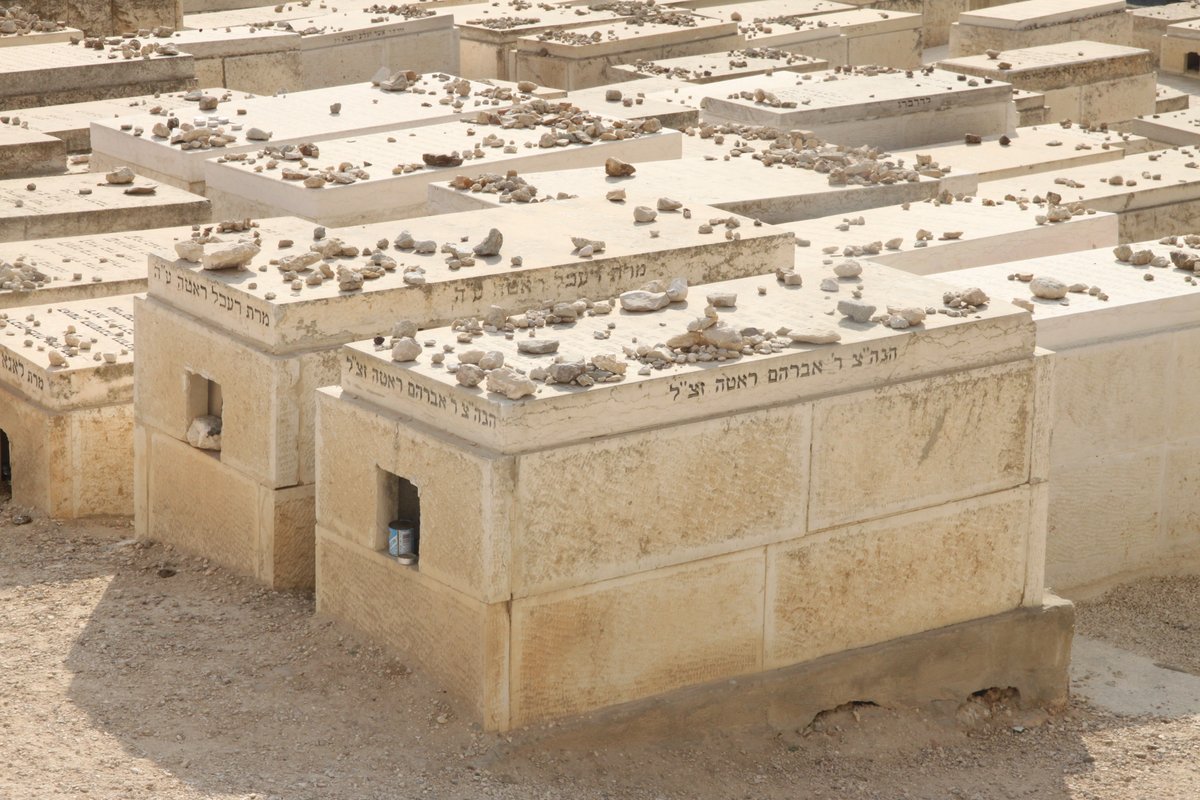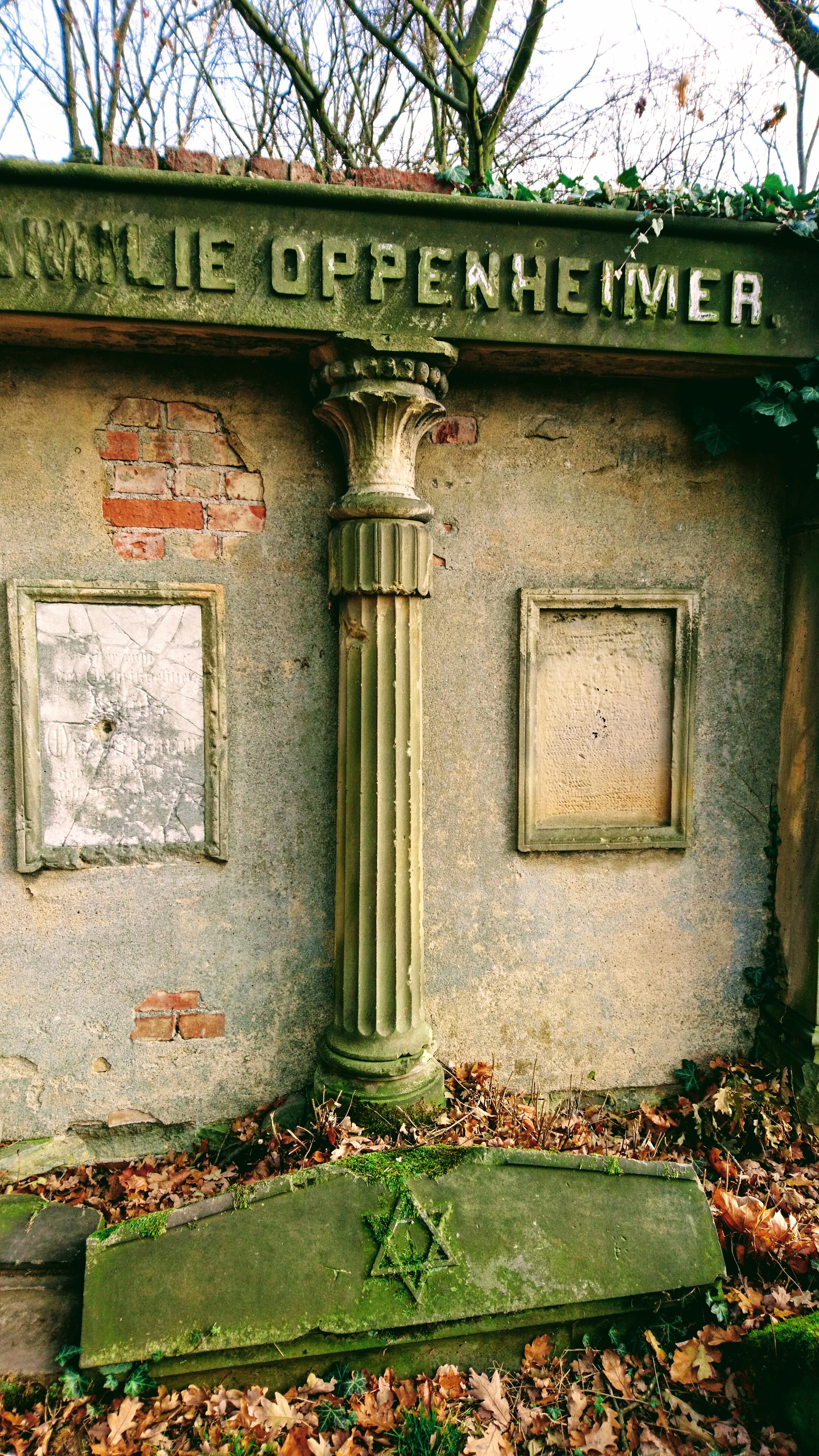Jewish Cemeteries on:
[Wikipedia]
[Google]
[Amazon]





 A Jewish cemetery ( he, בית עלמין ''beit almin'' or ''beit kvarot'') is a cemetery where Jews are buried in keeping with Jewish tradition. Cemeteries are referred to in several different ways in Hebrew, including ''beit kevarot'' (house of sepulchers), ''beit almin'' (eternal home) or ''beit olam aba'' (house of afterlife), the ''beit chayyim'' (house of the living) and ''beit shalom'' (house of peace).
The land of the cemetery is considered holy and a special consecration ceremony takes place upon its inauguration. According to Jewish tradition, Jewish burial grounds are sacred sites and must remain undisturbed in perpetuity. Establishing a cemetery is one of the first priorities for a new Jewish community. A Jewish cemetery is generally purchased and supported with communal funds. Placing stones on graves is a Jewish tradition equivalent to bringing flowers or wreaths to graves. Flowers, spices, and twigs have sometimes been used, but the stone is preferred because among the Jewish religion it is perceived specifically as a Jewish custom.
Showing proper respect for the dead (''kevod ha-met'') is intrinsic to Jewish law. The connection between the soul and the human body after death is an essential aspect of Jewish belief in the eternity of the soul. Thus, disinterring the dead, deriving benefit from a corpse or grave, or acting in any way that may be perceived as "ridiculing the helpless" (''l’oeg l’rash''), such as making derogatory remarks or joking, but also partaking in the pleasures or needs of the living, such as eating, drinking or smoking, are forbidden in the presence of the dead.
Showing proper respect for the dead also requires a prompt burial, the waiver of certain rabbinic restrictions on
A Jewish cemetery ( he, בית עלמין ''beit almin'' or ''beit kvarot'') is a cemetery where Jews are buried in keeping with Jewish tradition. Cemeteries are referred to in several different ways in Hebrew, including ''beit kevarot'' (house of sepulchers), ''beit almin'' (eternal home) or ''beit olam aba'' (house of afterlife), the ''beit chayyim'' (house of the living) and ''beit shalom'' (house of peace).
The land of the cemetery is considered holy and a special consecration ceremony takes place upon its inauguration. According to Jewish tradition, Jewish burial grounds are sacred sites and must remain undisturbed in perpetuity. Establishing a cemetery is one of the first priorities for a new Jewish community. A Jewish cemetery is generally purchased and supported with communal funds. Placing stones on graves is a Jewish tradition equivalent to bringing flowers or wreaths to graves. Flowers, spices, and twigs have sometimes been used, but the stone is preferred because among the Jewish religion it is perceived specifically as a Jewish custom.
Showing proper respect for the dead (''kevod ha-met'') is intrinsic to Jewish law. The connection between the soul and the human body after death is an essential aspect of Jewish belief in the eternity of the soul. Thus, disinterring the dead, deriving benefit from a corpse or grave, or acting in any way that may be perceived as "ridiculing the helpless" (''l’oeg l’rash''), such as making derogatory remarks or joking, but also partaking in the pleasures or needs of the living, such as eating, drinking or smoking, are forbidden in the presence of the dead.
Showing proper respect for the dead also requires a prompt burial, the waiver of certain rabbinic restrictions on
About surveys project
EJSF
IAJGS International Jewish Cemetery Project
Database of European Jewish Burial GroundsJewish Burial Grounds: Understanding Values - Historic England
{{Authority control

 A Jewish cemetery ( he, בית עלמין ''beit almin'' or ''beit kvarot'') is a cemetery where Jews are buried in keeping with Jewish tradition. Cemeteries are referred to in several different ways in Hebrew, including ''beit kevarot'' (house of sepulchers), ''beit almin'' (eternal home) or ''beit olam aba'' (house of afterlife), the ''beit chayyim'' (house of the living) and ''beit shalom'' (house of peace).
The land of the cemetery is considered holy and a special consecration ceremony takes place upon its inauguration. According to Jewish tradition, Jewish burial grounds are sacred sites and must remain undisturbed in perpetuity. Establishing a cemetery is one of the first priorities for a new Jewish community. A Jewish cemetery is generally purchased and supported with communal funds. Placing stones on graves is a Jewish tradition equivalent to bringing flowers or wreaths to graves. Flowers, spices, and twigs have sometimes been used, but the stone is preferred because among the Jewish religion it is perceived specifically as a Jewish custom.
Showing proper respect for the dead (''kevod ha-met'') is intrinsic to Jewish law. The connection between the soul and the human body after death is an essential aspect of Jewish belief in the eternity of the soul. Thus, disinterring the dead, deriving benefit from a corpse or grave, or acting in any way that may be perceived as "ridiculing the helpless" (''l’oeg l’rash''), such as making derogatory remarks or joking, but also partaking in the pleasures or needs of the living, such as eating, drinking or smoking, are forbidden in the presence of the dead.
Showing proper respect for the dead also requires a prompt burial, the waiver of certain rabbinic restrictions on
A Jewish cemetery ( he, בית עלמין ''beit almin'' or ''beit kvarot'') is a cemetery where Jews are buried in keeping with Jewish tradition. Cemeteries are referred to in several different ways in Hebrew, including ''beit kevarot'' (house of sepulchers), ''beit almin'' (eternal home) or ''beit olam aba'' (house of afterlife), the ''beit chayyim'' (house of the living) and ''beit shalom'' (house of peace).
The land of the cemetery is considered holy and a special consecration ceremony takes place upon its inauguration. According to Jewish tradition, Jewish burial grounds are sacred sites and must remain undisturbed in perpetuity. Establishing a cemetery is one of the first priorities for a new Jewish community. A Jewish cemetery is generally purchased and supported with communal funds. Placing stones on graves is a Jewish tradition equivalent to bringing flowers or wreaths to graves. Flowers, spices, and twigs have sometimes been used, but the stone is preferred because among the Jewish religion it is perceived specifically as a Jewish custom.
Showing proper respect for the dead (''kevod ha-met'') is intrinsic to Jewish law. The connection between the soul and the human body after death is an essential aspect of Jewish belief in the eternity of the soul. Thus, disinterring the dead, deriving benefit from a corpse or grave, or acting in any way that may be perceived as "ridiculing the helpless" (''l’oeg l’rash''), such as making derogatory remarks or joking, but also partaking in the pleasures or needs of the living, such as eating, drinking or smoking, are forbidden in the presence of the dead.
Showing proper respect for the dead also requires a prompt burial, the waiver of certain rabbinic restrictions on Shabbat
Shabbat (, , or ; he, שַׁבָּת, Šabbāṯ, , ) or the Sabbath (), also called Shabbos (, ) by Ashkenazim, is Judaism's day of rest on the seventh day of the week—i.e., Saturday. On this day, religious Jews remember the biblical storie ...
and religious holidays to ensure proper care of the dead, the ritual cleaning (''tahara'') and dressing of the body in shrouds (''tachrichim'') before burial, and laws concerning proper conduct in a cemetery.
To ensure that the requirements for Jewish burial are met and that each member of the community is afforded a proper burial, Jewish communities establish burial societies known as the Chevra Kadisha (''The Holy Society'') to provide these services free of charge. In larger Jewish communities, cemeteries are sometimes subdivided into sections according to the ''chevra kadisha'' that uses and is responsible for that section of the cemetery's care and upkeep.
History
Early Jewish cemeteries were located outside of the city. In theDiaspora
A diaspora ( ) is a population that is scattered across regions which are separate from its geographic place of origin. Historically, the word was used first in reference to the dispersion of Greeks in the Hellenic world, and later Jews after ...
, it is traditional to bury the dead with the feet in the direction of Jerusalem. The tombstones usually have inscriptions in Hebrew and the regional language. During the Nazi Germany regime, Jewish cemeteries all over Europe were destroyed and desecrated; for this reason, some cemeteries have therefore also become Holocaust memorials, such as the cemetery in the Warsaw Ghetto.
The largest Jewish cemeteries of Europe can be found in Budapest, Łódź, Prague, Warsaw, Vienna and Berlin. Other Jewish cemeteries in Europe include the Jewish Cemetery in Khotyn
The Jewish cemetery of Khotyn, Ukraine.
Background
The city of Khotyn is located in the Chernivtsi oblast of Ukraine. According to the Encyclopedia of Ukraine, during the late 19th and early 20th centuries, the town was almost entirely Jewish or ...
and the Chatam Sofer Memorial (part of the Old Jewish Cemetery in Bratislava
Bratislava (, also ; ; german: Preßburg/Pressburg ; hu, Pozsony) is the Capital city, capital and largest city of Slovakia. Officially, the population of the city is about 475,000; however, it is estimated to be more than 660,000 — approxim ...
). Founded in 1832, the Jewish Cemetery of Coro
The Jewish Cemetery of Coro (Spanish: ''Cementerio Judío de Coro'') is the oldest Jewish cemetery in continuous use in the Americas.
History
Its origin can be located in the 19th century, when Spanish and Portuguese Jews from the Dutch colony of ...
, in Venezuela is the oldest Jewish cemetery in continuous use in the Americas
The Americas, which are sometimes collectively called America, are a landmass comprising the totality of North and South America. The Americas make up most of the land in Earth's Western Hemisphere and comprise the New World.
Along with th ...
.
Jewish cemetery projects
The mission of the International Jewish Cemetery Project is to document every Jewish burial site in the world. The Lo Tishkach European Jewish Cemeteries Initiative was established in 2006 as a joint project of the Conference of European Rabbis and theConference on Jewish Material Claims Against Germany
The Conference on Jewish Material Claims Against Germany, or Claims Conference, represents the world's Jews in negotiating for compensation and restitution for victims of Nazi persecution and their heirs. According to Section 2(1)(3) of the Proper ...
. It aims to guarantee the effective and lasting preservation of Jewish cemeteries and mass graves throughout the European continent.
The ESJF European Jewish Cemeteries Initiative was established in 2015 as a German-based nonprofit. It received the initial grant of 1 million euros from German government in 2015 In November 2018 the EJSF received a European Union grant for a mass survey project of Jewish burial sites using drones. In December 2019 further funding was granted for a new 2019-2021 project "Protecting the Jewish cemeteries of Europe: Continuation of the mapping process, stakeholders’ involvement and awareness raising".EJSF
See also
*Bereavement in Judaism
Bereavement in Judaism () is a combination of ''minhag'' and ''mitzvah'' derived from the Torah and Judaism's classical rabbinic texts. The details of observance and practice vary according to each Jewish community.
Mourners
In Judaism, the p ...
* :Jewish cemeteries by country
References
External links
IAJGS International Jewish Cemetery Project
Database of European Jewish Burial Grounds
{{Authority control